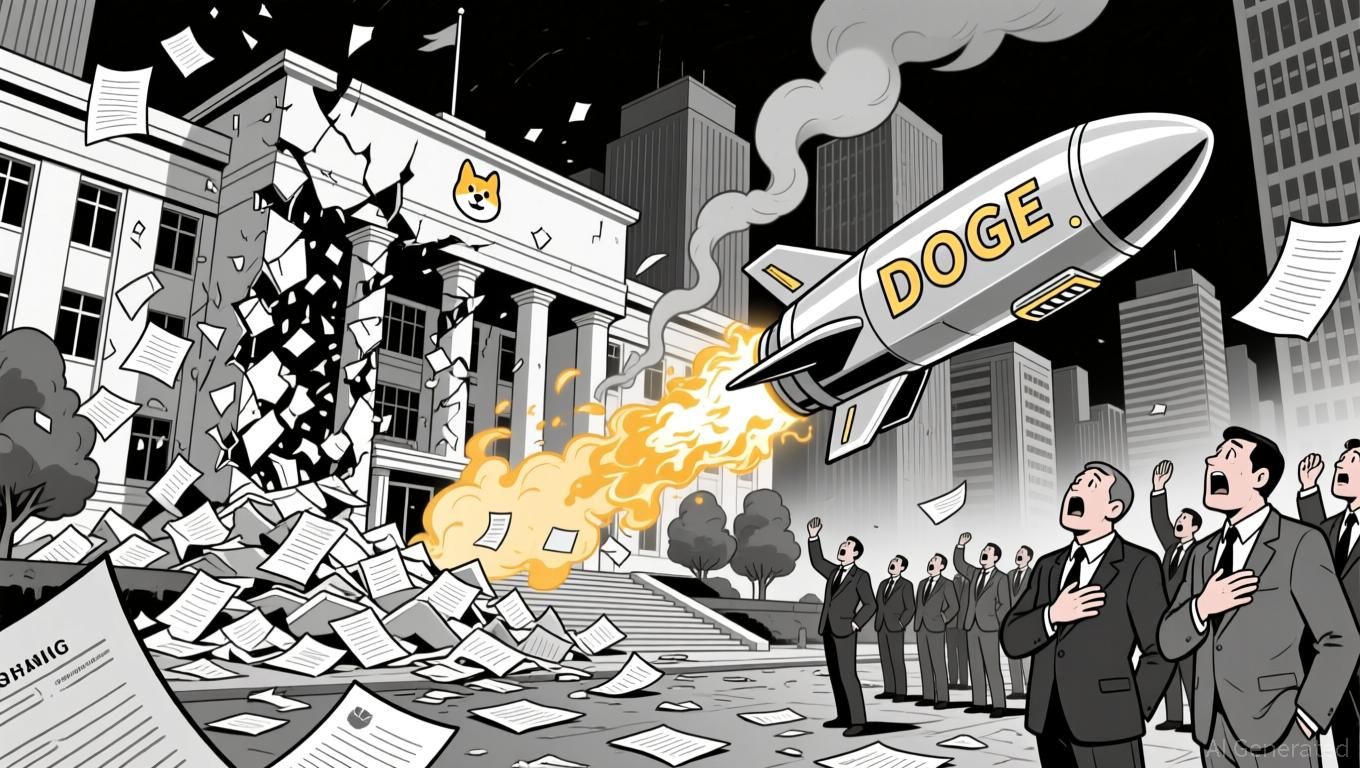DOGE drops by 0.22% as Government Efficiency Agency Faces Dissolution
- The Trump-era DOGE agency, dissolved 8 months early in Nov 2025, aimed to cut $2 trillion in federal spending but struggled with coordination and lacked legislative framework. - Despite Elon Musk's involvement and $335M in reported savings, DOGE's erratic operations and internal disputes led to its absorption into the Office of Personnel Management. - Legal challenges persist as former USAID staff seek transparency, while supporters argue its efficiency principles remain active despite the abrupt shutdow
As of NOV 25 2025,
Disbandment Confirmed, But Debate Persists
The Department of Government Efficiency (DOGE), which was launched at the start of 2025, has been officially shut down eight months before its planned end date. Created during the Trump administration, the agency’s mission was to reform federal operations by cutting waste and boosting efficiency. By November 2025, OPM Director Scott Kupor announced that DOGE “no longer exists,” marking the conclusion of its work. Nevertheless, DOGE’s official X account continued to assert its ongoing activities, highlighting recent contract cancellations that reportedly saved taxpayers $335 million.
Initially, DOGE was promoted as a groundbreaking effort to reduce federal expenditures, aiming to slash up to $2 trillion. The initiative attracted significant attention, partly due to Elon Musk’s public involvement. However, the agency faced difficulties coordinating with other federal bodies and lacked a solid legislative or regulatory base, which contributed to its premature closure.
Financially, DOGE’s performance has been marked by both potential and volatility. While the agency set out with ambitious targets, its inconsistent progress has led experts to call for more stable, long-term planning. Analysts have cited the unpredictable nature of its operations as a major reason for its failure to meet original expectations.
Operational Setbacks and Internal Struggles
Warning signs of DOGE’s decline were visible well before the formal announcement. Senior officials began moving to other government roles, and major projects either stalled or lost traction. Disputes over leadership and coordination problems with established agencies hampered DOGE’s effectiveness. Critics pointed to a lack of openness and measurable results as undermining the agency’s credibility, while supporters attributed the limited achievements to bureaucratic pushback and insufficient independence.
The closure of DOGE prompts broader reflection on the sustainability of reform efforts led by prominent figures. DOGE’s top-down restructuring strategy failed to mesh with existing government frameworks. Consequently, its main responsibilities have been transferred to the Office of Personnel Management (OPM), with ongoing efficiency initiatives now managed through conventional administrative processes rather than the disruptive approach DOGE had championed.
DOGE’s brief existence can be seen as a test case in public administration:

Diverse Responses and Unclear Prospects
The end of DOGE has led to a range of responses. Federal workers and contractors now face ambiguity about which reforms will persist and which may be rolled back. Some labor groups have supported the dissolution, citing worries about transparency and job security, while others caution that partially implemented changes could cause inconsistencies.
For DOGE’s advocates, the agency’s sudden closure represents lost potential. According to Kupor, the administration still upholds the values of deregulation, fraud prevention, and efficiency, stating that the "principles of DOGE remain alive and well." However, the absence of a central authority overseeing these efforts raises doubts about their future effectiveness.
This article does not identify any cyclical patterns or trading tactics that correspond to the Supported Indicators & Events List.
Legal and Political Consequences
Legal disputes have arisen following DOGE’s shutdown. Both current and former USAID staff have initiated lawsuits seeking access to records and testimony about the agency’s activities. The Justice Department has opposed these requests, citing concerns over the separation of powers. Elon Musk, who was instrumental in DOGE’s formation, has withdrawn from public attention, though his role remains a focal point in ongoing legal proceedings.
The closure of DOGE signals a change in the administration’s reform strategy. Instead of relying on experimental oversight entities, the Trump administration appears to be returning to more traditional governance models. DOGE’s inability to achieve its ambitious aims highlights the difficulties of enacting swift, large-scale reforms within a complex government structure.
Disclaimer: The content of this article solely reflects the author's opinion and does not represent the platform in any capacity. This article is not intended to serve as a reference for making investment decisions.
You may also like
Bitcoin Updates: Institutional Investments in Bitcoin Face Challenges from DeFi’s Unused Liquidity and Security Issues
- DeFi faces $12B liquidity crisis with 95% capital unused, while Aerodrome Finance suffered DNS hijacking attacks exploiting front-end vulnerabilities. - Bitcoin's price drop below $90,000 triggered $1.425B ETF outflows, contrasting Harvard's $218M Bitcoin/gold investment as inflation hedge. - SEC accelerates crypto ETF approvals as Bitwise's XRP ETF launches, while Spark shifts focus to institutional infrastructure over retail apps. - Market turbulence highlights DeFi's security flaws and liquidity chall

Bitcoin News Update: Japan to Integrate Cryptocurrency with Conventional Finance in 2026 Reserve Requirement
- Japan's FSA will mandate crypto exchanges to hold reserves covering customer losses from hacks or breaches via 2026 legislation. - Reserve amounts will depend on trading volumes and historical risks, with insurance allowed to offset obligations. - The move aligns with global crypto regulations like EU's MiCA and aims to treat digital assets as formal financial products. - While enhancing investor protection for Japan's 12M crypto accounts, critics warn smaller exchanges may struggle with compliance costs

DASH drops 22.6% over the past week following insider stock sales
- DASH fell 22.6% over seven days amid insider sales and tax-related share surrenders. - Executives Adarkar and Sherringham sold shares via SEC-approved 10b5-1 plans through Morgan Stanley . - Directors Fang and Tang surrendered 2,505 shares ($491k total) to cover tax liabilities from equity compensation. - Insider activity reflects routine compliance measures, not bearish sentiment, as DASH approaches earnings release.

Stablecoin Market Exceeds $280B as ECB Warns of Potential Systemic Risks
- Stablecoin market exceeds $280B, driven by regulatory clarity and institutional adoption, capturing 8% of crypto assets. - ECB warns of systemic risks from stablecoin concentration, de-pegging events, and mass redemption "runs" threatening global markets. - USDC overtakes USDT in onchain activity due to regulatory alignment, with Circle's market cap rising 72% YTD to $74B. - ECB calls for global regulatory coordination to address cross-border arbitrage gaps and prevent destabilizing retail deposit shifts
